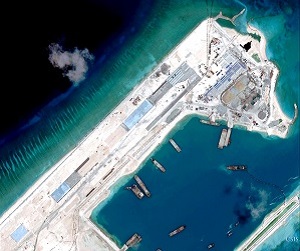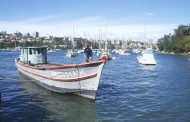Those closely following the situation in the South China Sea have been wringing their hands about the military potential of China’s unprecedented island building work over the last year. This anxiety is understandable, and the expanded patrol and surveillance capacity that Beijing is constructing with facilities, docks, and probably at least one airstrip in the Spratly Islands will complicate the disputes in the South China Sea. But fellow claimant states and outside governments also need to recognize the damaging effects this island-building campaign will have on the legal prospects of reaching an equitable solution to the disputes.
In June 2014, the Philippine government released photographs indicating Chinese efforts to expand, via dredging sand from the seafloor, five reefs that China occupies in the Spratly Islands: Cuarteron, Eldad, Gaven, Hughes, and Johnson. Since then, evidence has emerged of Chinese reclamation work at Fiery Cross Reef, which now appears capable of housing a small airstrip—just the fourth in the island group—and most recently at Mischief Reef. Most of these expansion efforts have since been confirmed by imagery from consulting firm IHS Jane’s and on-the-ground reporting by the BBC.
Of the features China is expanding, three—Gaven, Hughes, and Mischief—are among those the Philippines has asked a tribunal at the Permanent Court of Arbitration in The Hague to declare low-tide elevations. Another three—Cuarteron, Fiery Cross, and Johnson—are in the list of features Manila has asked the court to declare legally rocks, not islands. These definitions matter immensely in any attempt to reach a long-term system to manage the disputes in the Spratlys because they determine the maritime entitlements each feature generates.
A low-tide elevation creates no territorial sea, exclusive economic zone (EEZ), or continental shelf, and cannot be claimed as territory in its own right. It is legally part of the seabed and its only real effect on the maritime regime is that, if it lies within the 12 nautical mile territorial sea of another feature, it can be considered the baseline from which that rock or island’s entitlements are measured. A rock, which is distinguished from an island by not being able to sustain independent human habitation or economic life, generates a territorial sea but no EEZ or continental shelf.
A low-tide elevation cannot be made into a rock or island—the relevant article of the UN Convention on the Law of the Sea is explicit that the latter two must be “naturally formed” above water at high-tide. And while no court has yet ruled on the matter, there is broad consensus among legal experts that a rock cannot be made into an island. What matters is the original status of the feature, not what it is made into.
Determining the original status of a feature, especially in the Spratly Islands, is more difficult than might be expected. The 2012 International Court of Justice ruling on a dispute between Colombia and Nicaragua, which included a number of low-lying reefs and islets, underscored the high bar set for proving the status of features. Satellite imagery, or even aerial photography, are unlikely to be acceptable to a court except in the most obvious cases. Instead, judges will require rigorous geological surveys of features, preferably conducted during the highest tide of the year (the perigean spring tide, often called a “king tide”).
Accurate surveys in the South China Sea are notoriously lacking, and will prove impossible for features permanently modified by Chinese expansion. To be fair, Beijing is not the only claimant to perform reclamation work, but there is a qualitative difference between building new islands and preventing the erosion of existing ones (such as Vietnam has done at Spratly Island). The best hope for a long-term system to manage the disputes around the Spratlys requires agreeing to an area of legally disputed water and seabed (the disputes over the actual islands are irreconcilable for the foreseeable future) in which claimants can cooperate. That will require agreement on the status of features and their entitlements, either via negotiation or arbitration.
China’s reclamation work could make such agreement by negotiation significantly more difficult, and could make arbitration all but impossible. Claimants, and interested parties including the United States, should wake up to this danger and seek to head it off before any further damage is done. A joint survey of the Spratlys, performed by the Philippines and Vietnam, preferably with Brunei and Malaysia, and assisted by outside partners, should be launched this year. It is an endeavor that will prove useful to all claimants and which, as a cooperative scientific effort, should not be seen as escalating the disputes.
Gregory Poling
February 18, 2015
![]()













































